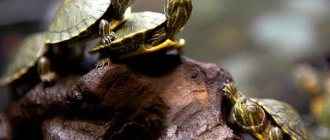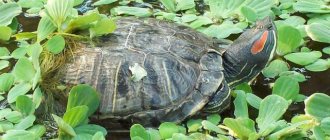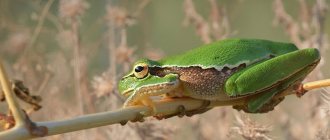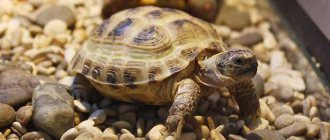The land turtle that lives in the house needs special care due to a number of differences from the usual furry pets: turtles are slow, sluggish and cold-blooded animals. These nuances need to be taken into account.
The family of land turtles includes about 40 species, but the steppe or Central Asian turtle is often chosen for home keeping. This is due to its low cost and small size. This species is characterized by a rounded shell, the color of which varies from dark olive to yellow-brown. The length of the turtle can reach 25 cm. In the wild, this species lives up to 50 years, at home with proper care - about forty years.
Description and natural habitat
The family of land turtles (Testudinidae) includes 16 genera and 57 species. Their sizes lie in a wide range - from small ones 10 cm long to giant ones, reaching more than a meter.
The Latin name translates as brick or tile.
Under natural conditions, the land turtle lives in Africa, Southern Europe, Central, South and North America, throughout Central Asia, preferring the steppe areas of China, Uzbekistan, and Kazakhstan. They can be inhabitants of steppes, savannas, deserts, and some species also inhabit tropical rainforests.
The soils on which these reptiles live can be sandy or loamy. Rocks and small hills are their favorite habitats, but the presence of grass and proximity to water are an indispensable condition.
As housing, turtles often choose ready-made burrows dug by other animals, but they can equip them themselves.
Despite the fact that the reptile is an inhabitant of arid zones, the soil must contain moisture. She won't be able to dig through anything too hard with her paws.
The features of these reptiles are as follows:
- Tall or flattened carapace. It is strong and durable and reliably covers the back (carapace) and belly (plastron) of the animal.
- The shell is capable of withstanding a very heavy load, more than 200 times the mass of the individual itself.
- The turtle's legs are elephant-like, short, powerful and massive, ending in fused toes and free claws.
- The tail is short, often triangular in shape with a sharp spike at the tip.
- Most species have inconspicuous colors - olive-gray or yellowish, brown both on the skin and on the shell.
- The legs, head and tail are covered with leathery scales and scutes.
- Some species, when in danger, emit sharp hissing sounds similar to those of a snake.
- This is a slow and leisurely animal. When in danger, it does not run away, but completely pulls its limbs and head into its shell.
- Another way to protect a land turtle is to suddenly empty its large bladder.
- Males are always smaller than females.
- They have a high life expectancy. For some types it is 50 years, for others 100 and even 150.
Reviews from aquarists
Reviews from owners are varied. Someone expresses complete delight, another begins to hate the animal.
Characteristics and varieties
There are many different types of land turtles in the world, and not all of them are suitable for home keeping. But they are all born very small, up to 3 cm in length. And such a baby can grow into a giant weighing 900 kg.
Species that reach no more than 25-30 cm in adulthood are used as pets.
The most famous and widespread species of land turtles in the world are as follows.
Steppe Central Asian
A small reptile that has lived at home for more than 50 years. They reach sexual maturity by the age of 10, and grow up to 30. The average size is about 20 cm. Distributed in Central Asia, Iran, Afghanistan, and Kazakhstan. The carapace is of small height and has a yellowish or brown tint. It consists of 13 links in the upper part, 25 in the side, the plastron includes 16 shields.
Mediterranean
This turtle is also called Greek or Caucasian. The color of the carapace may include olive, yellowish, and brown tones. The maximum size is up to 35 cm. There may be black spots on the scutes. The elephant-like legs end in 4 or 5 claws.
In nature, they are distributed in North Africa, Southern Europe, South-West Asia, the Caucasus, and Greece, Georgia, Dagestan, Azerbaijan, and Armenia.
Well suited for home keeping.
Leopard (panther)
A very large and beautiful turtle. Up to 70 cm long, weight up to 50 kg. In young turtles, the carapace shell is light beige with a dark pattern on each scute. With age, the color becomes dominated by black and yellow spots, reminiscent in their arrangement of the colors of a leopard.
Natural habitat is Africa, from Sudan to Ethiopia.
A very beautiful inhabitant of the terrarium. There is a known case of a long-lived panther being kept in captivity for up to 75 years.
European land turtles
These species live in Southern Europe, North Africa and Western Asia.
These are the following varieties:
- Toothed turtle;
- Greek;
- Balkan;
- Egyptian.
All these reptiles are small, bright and suitable for home keeping.
American land turtles
These are four species living in South America and the Galapagos:
- Coal or redleg;
- Argentine or Chilean;
- Jagged (forest shabuti);
- Galapagos or elephant.
Their sizes range from 25 to 150 cm. Three species are listed in the International Red Book.
Coal turtles have a tall black carapace with yellow spots. Their sizes reach 35-34 cm. They are kept at home in a special terrarium.
The Chilean tortoise is small, up to 25 cm, common in Argentina, Chile, Bolivia, and Paraguay. Almost exterminated by man.
Shabuti is a very beautiful large (up to 60 cm) turtle. It has a bright brown shell with a yellow spot on each scute. The number of this species is rapidly declining.
Brown
It lives in Southeast Asia, Sumatra, India - in monsoon evergreen forests. This is a fairly large species - the size of individuals reaches 50 cm and a weight of 30 kg.
The only land turtle that builds a special nest for its offspring and protects the clutch.
The meat of the brown turtle is highly valued by the local population; medicines are prepared from the shell. Uncontrolled destruction has led to a significant decline in the species.
Depressed
A very bright and beautiful turtle with a body length of up to 30 cm. It lives in Vietnam, Laos, Thailand, Malaysia, and Burma.
Not suitable for home keeping; it dies quickly in captivity.
Star-shaped
Natural habitats: India, Pakistan, Sri Lanka. Maximum dimensions: 15 cm for a male, 25 cm for a female.
The carapace shell is beautiful and bright. Each grey-green scute has a yellow, raised star pattern.
It is highly valued by professionals and is a decoration for any terrarium. In captivity, it lives up to 80 years.
Madagascar beak-breasted (Angonoka)
Large turtle, up to 50 cm body length. The endemic island of Madagascar is very beautiful. It has raised patterns on the olive-gray carapace.
Now the number of this unusual species in nature is still small, it is maintained in the zoos of New York, San Marino and Honolulu.
Burmese
A very bright small turtle (up to 25 cm) is endemic to Burma. The black or dark brown carapace on each scute has a bright yellow pattern of rays diverging in different directions.
Almost exterminated by the inhabitants of the island. Since ancient times, people have eaten meat, and shells have been used as kitchen utensils.
Indian
The small (up to 28 cm) turtle is endemic to India. The carapace is bright - from light to dark brown. It gets along well with humans, but the number of the species has greatly decreased due to the widespread consumption of animal meat by the indigenous population.
desert gopher
Inhabitant of the deserts of North America and Mexico. Body dimensions are from 22 to 27 cm, the shell is gray-green.
Due to population decline, it is under human protection. Breeds extensively in zoos in Arizona and San Diego.
Well suited for terrarium keeping.
Mexican gopher
This turtle is endemic to Mexico. It has a dome-shaped carapace of a gray-green or brown hue, dimensions up to 40 cm. Due to the high decline in numbers, the species is under the protection of Mexico and the United States, and is propagated in zoos.
Texas gopher
A small and bright turtle, usually 15-20 cm. The carapace scutes are dark brown or almost black with a yellow spot in the middle. It lives in the USA and Mexico; sale and collection of individuals is prohibited.
Gopher polyphemus
The tall and dome-shaped carapace is brown, with a light border along the edge of each scute. The size of an adult is up to 37 cm. It lives in the USA (South Carolina, Georgia, Alabama, Mississippi, Louisiana). This species digs very long burrows for itself - up to 15 m.
Due to declining numbers, it is protected by law and breeds in zoos.
Giant species include the elephant or Galapagos tortoise, the Seychelles giant tortoise and some others.
Photo gallery of land turtles:
Price
The cost of an individual varies from 200 rubles to 150,000 or more for rare species. The refusenik can be found on websites for free.
| Name | Price (rubles) |
| Greek, Mediterranean (Testudo graeca) | 2160–4800 |
| Leopard, Panther (Stigmochelys pardalis) | 3840–7680 |
| Indian starfish (Geochelone elegans) | 5000–12000 |
| Redfoot, Charcoal (Chelonoidis carbonaria) | 3840–4800 |
| Madagascar radiata (Astrochelys radiata) | 24000 |
| Central Asian (Agrionemys horsfieldii) | 500–3000 |
Prices depend on characteristics:
- floor;
- age;
- rarity of the species.
Care and maintenance of land turtles at home
Keeping a land turtle at home is not difficult, but it does require the arrangement of a special terrarium. If you do not provide for it, but let the reptile crawl on the floor, then the pet can easily catch a cold, get injured, or catch an inspection.
For the first time, you can set up a newly acquired turtle in a spacious cardboard box and start making a comfortable terrarium.
Its dimensions must be quite large, since an adult can grow up to 20 cm, and some species up to 30-35 cm.
The minimum dimensions of a terrarium for one pet are 110x50x40 cm. You should not arrange a pile of sticks and branches in it, the animal needs enough space to move, it is not such a slow creature as is commonly believed.
You can add clay or sand to the bottom of the terrarium, but the soil must first be disinfected. It is better to cover the bottom with sawdust, purchasing them at a pet store. They are easy to change (1-2 times a month) when they get dirty.
A small house, a kind of shelter, should be provided in the room. It can be made from a small cardboard box, plywood, wood or durable plastic.
To maintain optimal temperature conditions, an incandescent lamp with a power of at least 75 W is installed in the upper part of the terrarium.
In the shady part the temperature should be about +30 °C, in the rest - +37...+40 °C.
About once a week the turtle needs water treatments. To do this, water with a temperature of about +25 °C is poured into a small flat basin. There should be enough liquid to cover the animal's body to the middle of the neck.
Purchase
Before getting a turtle, read the description of care features and purchase everything you need to ensure a comfortable life. Be prepared for additional costs associated with keeping turtles in your home.
After purchasing, take your turtle to the vet. He will determine the age and sex of the animal, and examine it for wounds, injuries, infections, and diseases.
In a new place, the turtle will need an adaptation period to get comfortable. Do not disturb her again, provide proper care and nutrition.
Expenses
In addition to a terrarium or aquarium with additional equipment, a heating lamp, include in the cost of good quality food, examination or treatment by a veterinarian.
Feeding
In the wild, this reptile feeds mostly on plant foods and consumes small amounts of protein in the form of worms and snails.
The same diet must be provided to the pet at home. It should contain vegetables, fruits, as well as small insects and pieces of meat.
Feed the turtle once a day. The pet does not need water; the reptile’s body extracts liquid from juicy food.
Also read the article about what to feed land turtles.
Adviсe
- The turtle will not play like a cat or dog.
- Protect your pet from drafts, feed it a variety of food, and treat it on time.
- Think carefully about the purchase, because the pet lives quite a long time, and if released into the wild, it will die in the natural conditions of central Russia.
Turtle is a great choice for people who don't like noise. A leisurely turtle relaxes and clears the mind of hustle and bustle, and taking care of it brings true pleasure.
Previous
Inhabitants of the 12 most popular species of snails in the aquarium
Next
Inhabitants7 main components for feeding the red-eared turtle
Diseases and prevention
The land turtle rarely gets sick. Improper living conditions and poor diet can lead to the appearance of some pathologies.
The most common diseases found in these pets are:
Rickets
This disease develops due to a lack of vitamin D and ultraviolet rays. It manifests itself in softening and deformation of the carapace and plastron.
In the early stages, pathology can be dealt with by revising the diet and installing an ultraviolet lamp in the terrarium.
If the disease has progressed far, then it is necessary to contact a veterinary clinic and undergo a course of injections of fortified calcium. But the curvature of the shell will most likely remain with the pet forever.
It is much easier to prevent the disease. To do this, you need to take your pet for a walk under the warm rays of the sun. And adjust your diet so that it contains enough calcium and vitamins.
Eye diseases
If your tortoise's eyes begin to water and swell, and the eyelids stick together and are difficult to open, then most likely there is a lack of vitamin A in the diet.
It is necessary to prepare a warm solution of chamomile and wash your pet’s eyes several times a day using a sterile cotton swab. Albucid and Sofradex eye drops are also used. Your veterinarian will likely prescribe multivitamin injections.
Nutrition needs to be reviewed and the diet adjusted.
Helminthiasis
If your pet begins to suffer from diarrhea or constipation, and whitish moving dots are visible in the excrement, then an infection with internal parasites has occurred.
They could enter the turtle’s body along with low-quality live or raw food, or dirty terrarium filler.
In this case, you should contact a veterinary clinic to prescribe treatment. And as a preventative measure, it is advisable to deworm your pet once every three months.
For turtles, the anthelmintic Wolbazen (Albendazole) is most often used.
acute respiratory infections, pneumonia
The first signs of colds in turtles are pale mucous membranes. Then difficulty breathing, runny nose, drool with white foam, and wheezing appear.
Pneumonia rarely develops in land species; aquatic turtles are more prone to it.
At the slightest sign of a cold, you should contact your veterinarian and begin antibacterial therapy. Antibiotic injections are usually prescribed.
Intestinal obstruction
This problem can arise if the pet has eaten some inedible objects, pieces of rubber, or polyethylene.
A symptom of pathology is stool irregularity. You should try sun and warm water baths; in extreme cases, an enema with chamomile decoction will help.
Infection with external parasites
If small moving dots are found on the turtle's body, then the pet has lice or fleas.
For treatment, a 5% solution of Karbofos is applied to the skin of the reptile and after a while it is washed off with a 0.2% solution of Neguvon.
Interesting facts about land turtles
Land turtles appeared on planet Earth a long time ago and are one of the most ancient inhabitants.
The sex of turtles can be predicted. It depends on the conditions in which the eggs were located. Males are born if the eggs develop at low temperatures, females - at high temperatures.
In one museum in Ukraine, turtle eggs lay on display shelves for a long time. They were used as exhibits. But one day they burst and turtles were born.
Turtles are not considered aggressive towards humans. Only caiman species during the mating season can mistake a person for a rival and attack him.
Since ancient times, turtle meat has been revered as an exquisite delicacy. It can be consumed raw or after heat treatment. Turtle shells make beautiful jewelry and tableware.
Males during the mating season may mistake a person for a rival
Natural enemies
In the natural environment, turtles have many enemies, even though the animals have reliable protection - a shell. Reptiles are hunted by eagles, hawks and other birds of prey. To defeat the reptile, predators drop stones from a height and peck out its entrails.
Crows and jackdaws pose a danger to children. They completely swallow baby turtles that have just hatched from their eggs. Even foxes throw reptiles off cliffs to split the carapace and eat the animals.
Jaguars are the enemies of turtles in South America. Rodents bite off their tail and paws.
Note!
Sick turtles move so slowly that the soft parts are eaten by ants. Only Galapagos tortoises have no enemies. This is the only species distinguished by its impressive size and weight.
Population and species status
There are 228 species of turtles under protection. Of these, 135 species are on the verge of extinction.
Among land turtles, the least common species is the Central Asian land turtle.
Reasons that influence population decline:
- illegal fishing;
- unsustainable agricultural activities;
- construction of facilities.
In addition to the above factors, land turtles are caught by poachers for the purpose of sale for reproduction and breeding at home, sometimes not suitable for a particular species.
Turtle meat is a valuable delicacy. The unpretentiousness of reptiles has contributed to the fact that they are transported over long distances. The shell is used to make hair ornaments and use them for souvenirs.
The most famous rare endangered species is the Central Asian land turtle
Conservation of land turtles
Different countries are using all sorts of methods to try to combat the extinction of many species of land turtles.
- Rare species are prohibited for export, strict bans are imposed on turtle hunting, and trade in reptile meat, shells and eggs is prohibited. Authorities regularly raid markets and airports to prevent unauthorized exports and sales of prohibited items.
- Carrying out events whose purpose is to appeal to sanity and awareness of consumers. For example, in Mexico, for more than 20 years, authorities have been urging people not to buy trinkets and jewelry, and not to order turtle meat dishes in restaurants. Many species have been protected for many years, but more recently, the laws of many countries have included articles providing for criminal penalties for trade in turtles.
- There is a fight against the cultivation of turtles on special farms where they are bred and raised for meat. The animals are kept in terrible conditions. Many individuals are sick.
A website was created on the Internet that advocated a complete ban on turtle farms. To restore the population of endangered animals, people must come together and work together to restore it.
Reproduction
It is almost impossible to determine the sex of a land turtle under 2 years of age. Signs that can be used to identify an older animal are as follows:
- Dimensions. Females are slightly larger than males. Using this feature, it is possible to identify a male only if there are several individuals in the terrarium.
- Carapace and plastron. In the lower part, the bone plates of males are concave, since during mating they climb onto females. In females, the carapace is more rounded, in male specimens it is elongated.
- The claws of males are sharper and stronger than those of females. With their help, males hold females during mating.
- The tail of males is wider, more powerful and longer, since it contains the genital organ.
- Eye color will also help determine the sex of the turtle. In the female they are usually yellow, and in the male they are brown.
In nature, mating of individuals occurs in the spring after the end of the winter period, during which some species hibernate.
Breeding at home is a rather difficult process. Mature animals are kept together, usually one male and a pair of females. To do this, you need to build a large terrarium or a warm outdoor enclosure. Pet turtles can mate year-round; all that is needed is adequate temperature and humidity, as well as increased nutrition.
In the banded turtle species, it is necessary to have one male per female, and in caiman turtles this ratio is 2:1.
To stimulate mating, turtles are hibernated during the winter and males and females are separated for a couple of months. Then the temperature in the enclosure or terrarium is gradually increased, simulating spring.
Sometimes they do without forced wintering, but simply shade the terrarium for three months, reducing the air temperature to the lower permissible limit, then also gradually increase the degree of room heating and illumination.
Daylight hours are increased to 14-15 hours, and turtles are sprayed with water from a spray bottle every day for the last two weeks, simulating rain. Then the male is placed with the females, in their room. In this case, the male will behave less aggressively.
If there are two males in the terrarium, then joints are possible between them and there is no need to prevent them to a reasonable extent.
Reproduction is easiest in Central Asian species; they usually do not need stimulation.
After mating has occurred, you need to monitor the female, and as soon as she lays a clutch, immediately move the eggs to the incubator. They mature in 2 to 6 months.
A large glass, clay or porcelain container or an aquarium can be used as an incubator. Peat mixed with river sand in a ratio of 3:2 is poured onto the bottom. It is advisable to pre-calcinate the soil. You can take moistened vermiculite - a special crystalline substrate used in plant growing.
The soil in the incubator must be moist, and the eggs must be placed in special nests - small holes, recessed to a third of the height. During the entire period of egg ripening, sand is lightly sprinkled with water along the edges of the vessel, while avoiding excessive moisture.
You can also place a small jar of water in the vessel; it will evaporate and maintain air humidity at the required level.
The incubator is covered from above, preferably with glass, which is removed a couple of times a week for ventilation.
The soil from below is heated with an electric lamp or a vessel is placed near the heating device. The main thing is to maintain a constant level of temperature and humidity. Therefore, it is better to equip the incubator with a hygrometer and thermometer.
Too high a temperature can destroy the clutch, so it wouldn’t hurt to install a special thermostat in the container with the baby turtles’ eggs.
After the turtles have hatched, there is no need to rush to remove them from the eggs. They feed on their plant solution for up to three days. Even when the baby is completely freed from the shell, the remains of the yolk sac remain on the plastron below.
Turtles can grow up to three months old, feeding only on this yolk. Sometimes they hibernate and spend up to six months in it, gradually growing up.
From the first days, young turtles are able to take care of themselves. They just need to be moistened from time to time to prevent dehydration.
When kept in a terrarium, babies begin to be fed plant foods from the second month of life, but they are given baths every week.
What not to do
- Color the shell.
- Allow it to hibernate.
- Give medications without consulting a specialist.
- Accommodate a new resident without quarantine for a month.
- Allow animals to play with the turtle.
- Keep the turtle on the floor.
- Leave without a shelter house.
- Use fabric, cotton wool, or wool instead of primer.
- Place aggressive pets together.
- Constantly feed the same thing.
- Cat, dog, human food.
- Animal food.
Pros and cons of home keeping
In order to understand whether a land turtle is suitable for keeping in the house, it is necessary to consider their advantages and disadvantages.
The advantages of these pets are:
- Unpretentiousness and ease of care and maintenance. It is enough to equip the simplest enclosure or terrarium and feed it once a day.
- No allergies. These pets have never caused irritation to the skin or respiratory tract of anyone.
- Minimum costs. They are inexpensive to purchase and their maintenance requires minimal investment, since turtles eat little and mostly greens, which in the summer, for example, can be collected at the dacha or in the park.
- Long lifespan. Land pets live at least 30 years.
- Safety for household members. This very peaceful creature is not capable of causing damage to people, other pets, or things and furnishings in the house.
The disadvantages of keeping land turtles include:
- Uniformity of behavior. These pets can hardly be called cheerful and playful. They do not run around the house or act as companions in entertaining children. They just quietly live their lives and you can only slowly watch them.
- Difficulty in overcoming pathologies. If these pets get sick, it is usually very difficult to cure them. There are very few herpetologist specialists in Russian veterinary clinics.
- Low level of cleanliness. Fungus often forms on turtle shells. And when they walk around the house, you have to collect waste products from them.
- Night noise. These reptiles love to make noise at night; the grinding noises can be very annoying for people with light sleep.
But all these disadvantages are easily leveled out if you position the terrarium correctly and properly care for your pet.
Taming
To help your turtle eat from your hands, feed it while holding the food with your fingertips. Remember, once your pet gets used to this way of eating, it will begin to chase its owner.
Initially, turtles are not very friendly towards people. To wean your animal from biting, pick it up more often without making sudden movements.
Turtles have excellent hearing; when giving food or before bathing, make the same sound and the pet will begin to respond to it.
Animals remember and recognize their owner. They love to watch what is happening in the room.
Habits are quickly formed regarding feeding times and daylight hours. Not receiving food at the usual time, the pet will sigh and move its head in disappointment.
Mr. Tail Explains: Common Mistakes
All problems with these unpretentious pets arise due to the owners’ ignorance of basic maintenance rules. Most often, turtle owners make the following mistakes:
- They do not provide any terrarium for their placement. The pet is forced to look for a secluded corner in the house on its own. He collects dust under cabinets and sofas, and can get hurt and catch a cold from drafts.
- They forget to install an ultraviolet lamp in the turtle's housing. The absence of this radiation spectrum can cause many diseases in your pet.
- Scales are forcibly removed from the skin and scutes from the shells during molting. This is absolutely forbidden to do so as not to injure your pet. When washing, use only a soft cloth.
- They keep several aggressive males together. This can lead to injury and even death to the turtles.
- Wash terrariums using homemade disinfectants. This can easily poison your pets. To clean their territory, you must have your own equipment and special means.
Compatibility
Turtles are loners. In their natural environment, they gather in groups for mating and fighting. Keep turtles together only if there is no other option and they are of the same species and size. But even then conflicts arise. Different breeds require different conditions of maintenance.
Keep exotic turtles separately.
They can coexist with some iguanas in large vertical terrariums. If you try to make friends with a small reptile, the latter may lose its tail or paws. Turtle secretions are poisonous to snakes.











